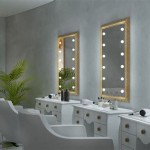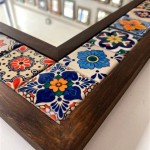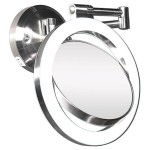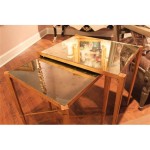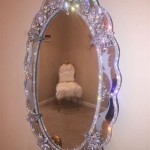Why Do Old Mirrors Get Black Spots?
The appearance of black spots, sometimes referred to as “foxing” or “silver mirroring,” on antique mirrors detracts from their beauty and reflects a natural process of deterioration affecting the reflective silver layer behind the glass. Understanding the science behind this phenomenon helps in appreciating the age of these mirrors and exploring methods for their preservation.
Antique mirrors were typically manufactured using a process involving applying a thin layer of silver nitrate to the back of a glass pane. This silver nitrate was then converted to metallic silver through a chemical reaction, creating the reflective surface. A protective copper layer and a coat of paint were then applied to seal and protect the silvering. The deterioration of this protective backing is the primary cause of black spots.
Moisture is a significant catalyst in the degradation process. When moisture penetrates the protective paint and copper layers, it reaches the silver layer. Silver is highly susceptible to oxidation, particularly in the presence of sulfur-containing compounds. These compounds can be present in the air, especially in areas with industrial pollution or near coastal regions. The reaction between silver and sulfur creates silver sulfide, a black compound, manifested as the dark spots on the mirror.
The quality of the original manufacturing process plays a crucial role in the mirror's longevity. In earlier times, the purity of the materials and the precision of the application could vary significantly. Mirrors with thinner or unevenly applied protective layers are more vulnerable to moisture ingress and subsequent silver sulfide formation. Imperfect sealing around the edges of the mirror also creates entry points for moisture and pollutants.
Temperature fluctuations contribute to the deterioration process. Expansion and contraction of the different layers – glass, silver, copper, and paint – caused by temperature changes can create micro-cracks in the protective layers. These tiny fissures provide pathways for moisture and air to reach the silvering, accelerating the formation of black spots.
Improper cleaning methods can also contribute to damage. Harsh chemicals or abrasive cleaning solutions can strip away the protective layers, exposing the silver to the elements. Even seemingly benign cleaning agents can cause damage over time if they are allowed to seep into the edges or any existing cracks in the backing.
The location where the mirror is stored or displayed influences its susceptibility to black spot formation. Areas with high humidity, poor ventilation, or exposure to direct sunlight accelerate the deterioration process. Damp basements, bathrooms, and attics are particularly unsuitable environments for antique mirrors.
While the formation of black spots is a natural aging process, certain preventative measures can slow down its progression. Storing mirrors in a climate-controlled environment with stable temperature and humidity levels can help to minimize damage. Avoiding exposure to direct sunlight and ensuring adequate ventilation are also important considerations.
Regular cleaning with gentle methods can help to prevent the buildup of dust and pollutants that can contribute to deterioration. Using a soft, dry cloth to dust the mirror surface is generally recommended. Avoid using commercial glass cleaners containing ammonia or vinegar, as these can damage the backing. If necessary, a slightly damp cloth can be used, followed by immediate drying.
Professional restoration is an option for severely damaged mirrors. Conservators specializing in antique mirror restoration can employ techniques to remove the black spots and re-silver the reflective surface. However, restoration can be a delicate and costly process, and it’s crucial to select a qualified professional with experience in handling antique mirrors. The goal of restoration is to preserve the historical integrity of the mirror while improving its appearance.
Understanding the scientific principles behind the formation of black spots on antique mirrors provides insights into their age and the environmental factors they have been exposed to. While the process of deterioration is inevitable, proper care and storage can help to slow down its progression and preserve these historical artifacts for future generations.
The presence of black spots, while sometimes perceived as a flaw, can also be viewed as a testament to the mirror’s age and history, adding to its unique character. These marks tell a story of time, environmental exposure, and the chemical processes that inevitably affect even the most carefully crafted objects.

How To Fix Black Spots On Old Mirrors Hunker

Fixing Black Spots On Mirrors How To Clean Mirror Frame Diy Antique

How To Repair Desilvering What Do About Black Edges On Mirrors

How To Fix Black Spots On Old Mirrors It Can T Be Fixed But Re Silver The Mirror Is Definitely Most Involved Option Home Repair Image House

How To Repair Desilvering What Do About Black Edges On Mirrors

Four Solutions For Dark Spots On Vintage Mirrors Homemate

The Ultimate Guide On Diy Antique Mirrors So Much Better With Age

How To Remove Dark Spots From Antique Mirrors

Mirror Repair Get Rid Of Black Spots S Haye Plumbing
Mirror Resilvering Frank Wright Glass

